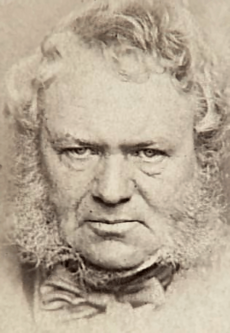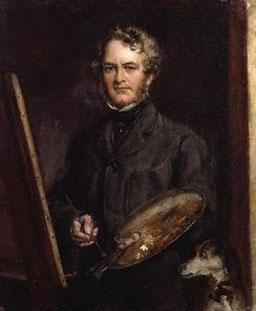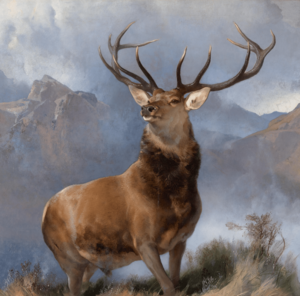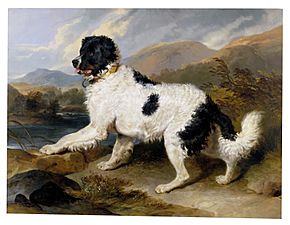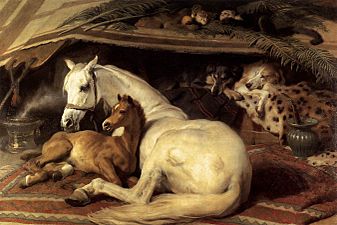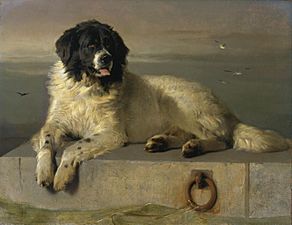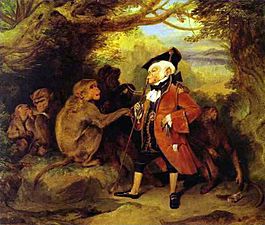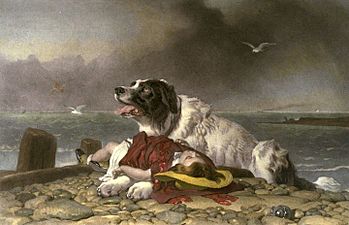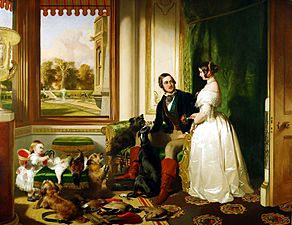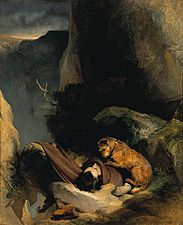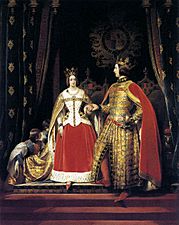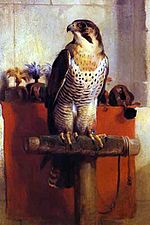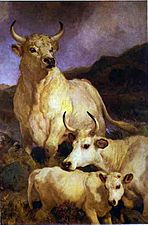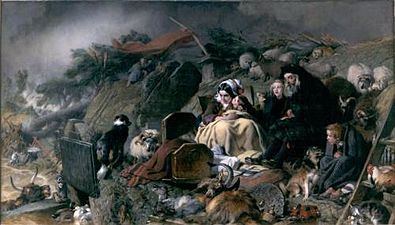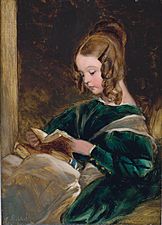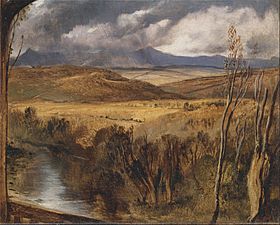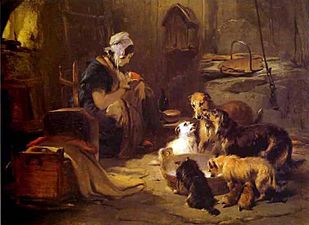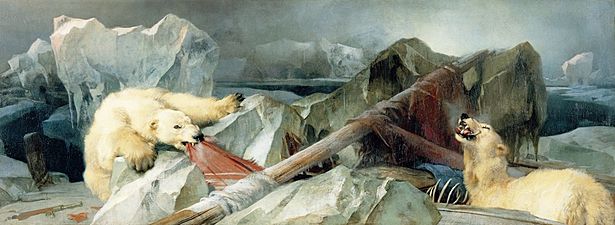Edwin Landseer facts for kids
Quick facts for kids
Sir
Edwin Landseer
|
|
|---|---|
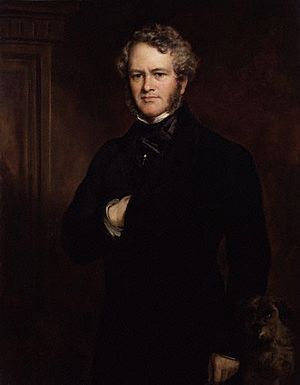
Portrait by Sir Francis Grant (1852)
|
|
| Born |
Edwin Henry Landseer
7 March 1802 London, England
|
| Died | 1 October 1873 (aged 71) London, England
|
| Education | Royal Academy Schools |
| Known for | Painting, sculpture |
| Movement | Animalier |
| Awards | Great gold medal of the Exposition Universelle (1855) |
Sir Edwin Henry Landseer RA (born March 7, 1802 – died October 1, 1873) was a famous English painter and sculptor. He was best known for his amazing paintings of animals, especially horses, dogs, and deer. You might know his most famous works: the large lion sculptures at the bottom of Nelson's Column in Trafalgar Square in London.
Contents
Life of Edwin Landseer
Edwin Landseer was born in London. His father, John Landseer, was an engraver. Edwin was a child prodigy, meaning his artistic talents were clear from a very young age.
He learned from several artists, including his father. He also studied with Benjamin Robert Haydon, a history painter. Haydon encouraged young Edwin to study animal bodies closely. This helped him understand how animal muscles and bones worked.
Landseer's life was closely connected to the Royal Academy, a famous art school. When he was just 13 years old in 1815, he showed his art there. He became an Associate of the Academy at 24, which was the youngest age allowed. Five years later, in 1831, he became a full Academician.
He was friends with Charles Robert Leslie, who said Edwin spent his time between studying wild animals and attending the Royal Academy Schools. In 1824, they visited Scotland together. This trip had a big impact on Landseer's art.
In 1850, Edwin Landseer was made a knight, so he became "Sir" Edwin Landseer. In 1866, he was asked to be the president of the Royal Academy, but he said no. Later in his life, Edwin Landseer faced some health challenges that affected his well-being. In 1872, his family had to declare him unable to manage his own affairs.
Landseer's Paintings
Landseer was a very important artist in 19th-century British art. You can find his paintings in famous places like Tate Britain and the Victoria and Albert Museum in London. He also worked with another painter, Frederick Richard Lee.
Edwin Landseer was incredibly popular in Victorian Britain. No one could match his skill as an animal painter. Much of his fame and money came from copies of his work. These copies were made as engravings, often by his brother Thomas.
One of his early paintings, Alpine Mastiffs Reanimating a Distressed Traveller (1820), is famous for starting a myth. It shows two St. Bernard rescue dogs in the Alps. One dog is barking for help, while the other has a small barrel around its neck. This painting led to the idea that St. Bernard dogs carry little barrels of brandy to help people.
Landseer's art was loved by everyone, from regular families to the rich and royal. Queen Victoria asked him to paint many pictures. He first painted her royal pets. Then, he painted portraits of her staff, like ghillies and gamekeepers. Before she married Prince Albert, the Queen asked Landseer to paint her portrait as a gift for Albert.
Landseer even taught Queen Victoria and Prince Albert how to etch. He painted portraits of their children when they were babies, often with a dog nearby. He also painted Victoria and Albert dressed up for costume balls. One of his last paintings was a large portrait of the Queen on horseback, shown in 1873.
Landseer especially loved Scotland. He first visited in 1824. The Highlands gave him ideas for many of his important paintings. These included The Hunting of Chevy Chase (1825–26) and An Illicit Whisky Still in the Highlands (1826–1829). Later, he painted famous works like the majestic deer study The Monarch of the Glen (1851). In 1828, he was asked to draw pictures for Sir Walter Scott's novels.
Landseer's paintings of dogs helping people were so popular. Because of him, a type of Newfoundland dog is now officially called a Landseer. This is the black and white variety of the dog. Landseer made these dogs famous as water rescue dogs in paintings like Off to the Rescue (1827) and A Distinguished Member of the Humane Society (1838).
Landseer's painting Laying Down The Law (1840) makes fun of lawyers by showing dogs acting like humans. It shows a group of dogs, with a poodle representing a judge.
Some of Landseer's later works, like Flood in the Highlands and Man Proposes, God Disposes (both from 1864), have a sadder feeling. Man Proposes, God Disposes shows two polar bears playing with bones from a failed Arctic trip. This painting is in the Royal Holloway, University of London. Students there have a tradition: they cover the painting with a flag during exams. This is because there's a rumor that the painting can make people feel strange if they sit near it during tests!
Landseer's Sculptures

In 1858, the government asked Landseer to create four bronze lions. These lions were for the base of Nelson's Column in Trafalgar Square. Landseer agreed, but he needed time to start. There were also delays because he wanted copies of real lion casts from an academy in Italy.
The lions were made and cast at the studio of Carlo Marochetti. Landseer faced some challenges during this time, which slowed down the work. The famous lion sculptures were finally put in place in 1867.
Death and Legacy
When Landseer died on October 1, 1873, many people in England showed their sadness. Shops closed their blinds, flags were lowered, and wreaths were placed on his bronze lions at Nelson's Column. Large crowds watched his funeral procession. Landseer was buried in St Paul's Cathedral in London.
At the time of his death, Landseer had three paintings that were not finished. He wished for his friend, the artist John Everett Millais, to complete them, which Millais did.
Interesting Facts
People used to say that Landseer could paint with both hands at the same time! For example, he could paint a horse's head with his right hand and its tail with his left hand, all at once. He was also known for painting very quickly when he felt inspired. However, he could also put off commissions for years.
The famous architect Sir Edwin Landseer Lutyens was named after him. Lutyens was Landseer's godson, as Lutyens' father was a friend of Landseer.
Gallery
- Paintings
-
The Wild Cattle of Chillingham, 1867
-
Flood in the Highlands, Aberdeen Art Gallery
See also
 In Spanish: Edwin Landseer para niños
In Spanish: Edwin Landseer para niños
- List of wildlife artists
- Lost artworks


